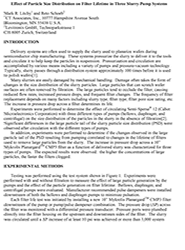Delivery systems are often used to supply the slurry used to planarize wafers during semiconductor chip manufacturing. These systems pressurize the slurry to deliver it to the tools and circulate it to help keep the particles in suspension. Pressurization and circulation are accomplished by various means including a variety of pumps and pressure-vacuum technology. Typically, slurry passes through a distribution system approximately 100 times before it is used to polish wafers.
Many slurries are easily damaged by mechanical handling. Damage often takes the form of changes in the size distribution of the slurry particles. Large particles that can scratch wafer surfaces are often removed by filtration. The large particles tend to occlude the filter, causing reduced flow rates, increased pressure drops, and frequent filter changes. The frequency of filter replacement depends on many factors including slurry type, filter type, filter pore size rating, etc. The increase in pressure drop across a filter determines its life.
Experiments were performed to determine the effect of circulating Semi-Sperse® 12 (Cabot Microelectronics Corporation) with three different types of pumps (bellows, diaphragm, and centrifugal) on the size distribution of the particles in the slurry in the absence of filtration. Significant differences in the large particle tail of the slurry particle size distribution (PSD) were observed after circulation with the different types of pumps.
In addition, experiments were performed to determine if the changes observed in the large particle tail of the PSD resulting from pumping correlated to changes in the lifetime of filters used to remove large particles from the slurry. The increase in pressure drop across a 10” Mykrolis Planargard™ CMP3 filter as a function of delivered slurry was characterized for three types of pumps. The expected results were observed: the higher the concentrations of large particles, the faster the filters clogged.



